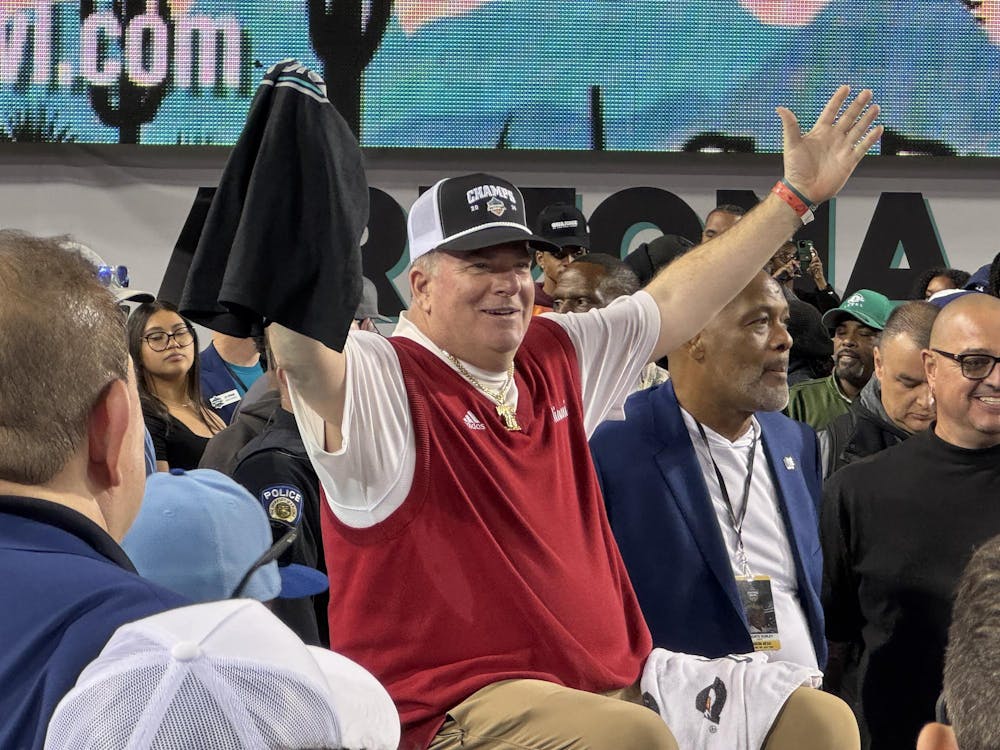Miami University officially opened the McVey Data Science Building on March 14. As part of the grand opening, former Major League Baseball player and Oakland Athletics General Manager Billy Beane spoke to the crowd full of alumni and students about his career, as well as the impact of data analytics in sports and the future it holds.
Before that, Beane spoke to sports analytics students about the importance of the industry. The event was moderated by Associate Professor Adam Beissel.
“As part of the kickoff and the ribbon cutting ceremony, they wanted to bring in somebody to speak to the growth of data analytics within society,” Beissel said. “He told us he has 30 minutes, and we crammed in as many questions as we could and invited our sports analytics students and also our sports analytics concentration students as well.”
During the Q&A session, Beane answered questions from students about his past career as a player and executive in major league baseball, as well as questions about the future of data analytics in sports.
As the industry changes, new skills are needed now more than ever. The need for traditional baseball scouts has decreased while the need for data scientists has increased.
“I want the same skills Google wants,” Beane said. “I want the same skills Goldman Sachs wants.”
As those skills are in more demand, Miami is giving students the opportunity to major in Sports Analytics as a combined program between the Department of Sports Leadership and Management (SLAM) and the Department of Information Systems and Analytics (ISA).
“We have about 100 total students doing sports analytics in all the various programs,” Beissel said. “Which, if you put that up in terms of the majors on campus, that would be one of the top 30 majors on campus.”
Beane’s “moneyball” approach, which was explored in the 2011 movie “Moneyball” starring Brad Pitt, has forever changed the way data is used in sports and the decision-making process sports teams use to acquire players and hire front office employees.
“A lot of what Billy does is he sort of prioritizes objective data around how to make decisions that controls for or eliminates the shortcuts to decision making that often impair objective assessment and judgment,” Beissel said.
After a modest six-year career, Beane became involved in the Athletics’ front office in 1990 and became general manager in 1997. By the time he stepped into his position as general manager, the Athletics changed ownership, and the new owners, Stephen Schott and Ken Hofmann, demanded a low payroll to save costs. That meant Beane and the rest of the front office were going to have to find new and innovative ways to win.
“It was a market, and we had a limited amount of money, so we had to be really efficient with it,” Beane said.
Enjoy what you're reading?
Signup for our newsletter
That’s where his famous “moneyball” strategy came to fruition.
“Guys like Bill James and Pete Palmer said that there’s a more efficient way to run a baseball team [and]that baseball teams were mispricing baseball players’ skills,” Beane said. “The most important skill a baseball player could have from a statistical standpoint was on-base percentage, but it was undervalued, it was about the ninth highest paid skill.”
Beane and the Athletic’s front office were able to take advantage of this. Despite consistently being towards the bottom of MLB in player payroll, the Athletics made the postseason 11 times during Beane’s time as GM from 1997-2022.
Data was so important to the Athletics that Beane said that they wanted to make decisions that resembled more of a hedge fund or investment company rather than a sports team.
“When we looked for inspiration, we weren’t looking for sports executives,” Beane said. “For us, we wanted to really calculate quantitative hedge funds. We wanted to know what John Meriwether was doing, what Simons was doing at Renaissance. We figured they were making these ruthless decisions based on information and that’s how we wanted to do it.”
During the ribbon cutting ceremony, Beane was joined by Miami University President Gregory Crawford and Richard McVey, the founder and chairman of MarketAxess. Crawford said that the $58 million building was designed to “introduce students to the best technology in the world” as well as “build a space to inspire creativity and innovation.”




